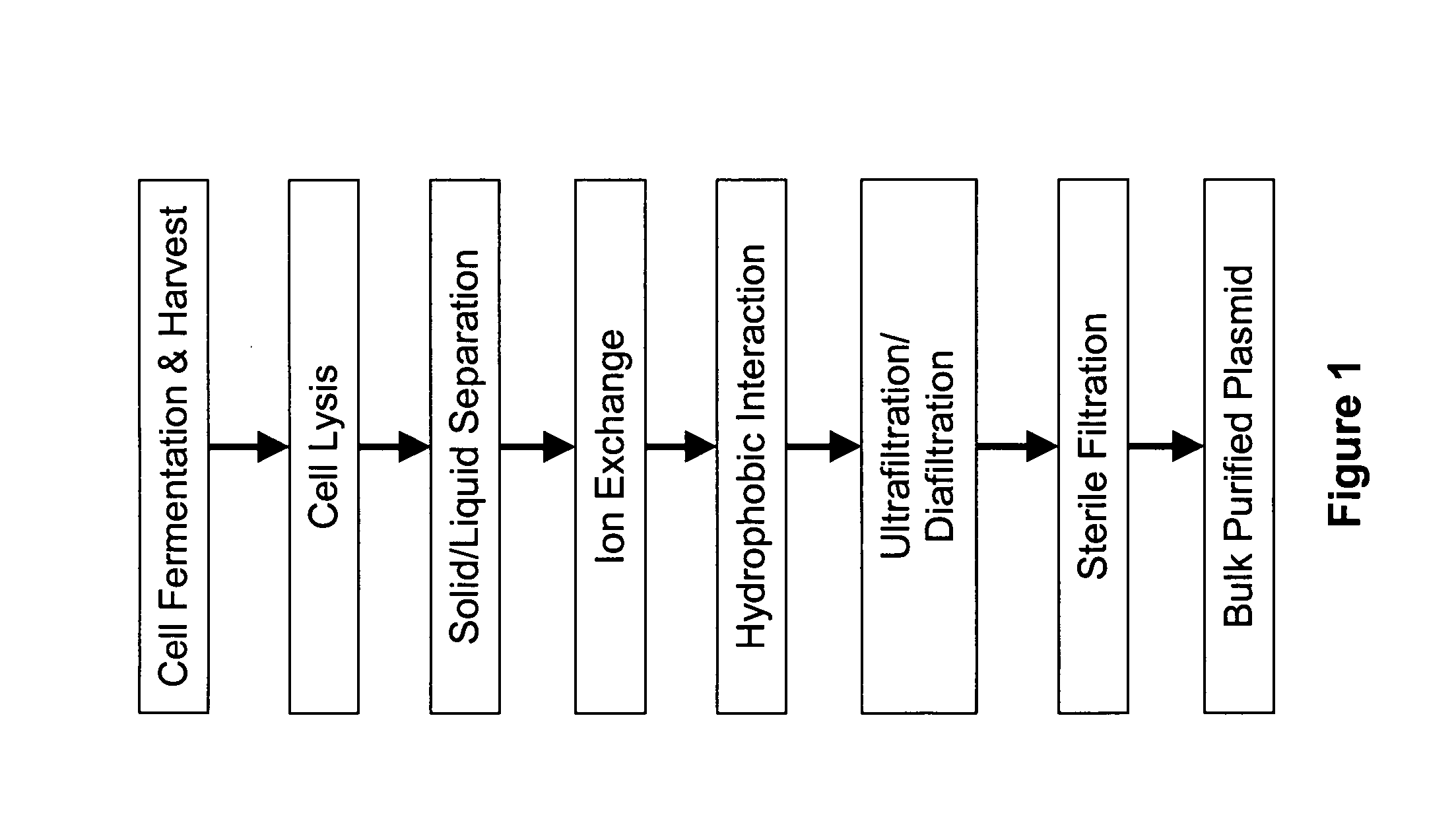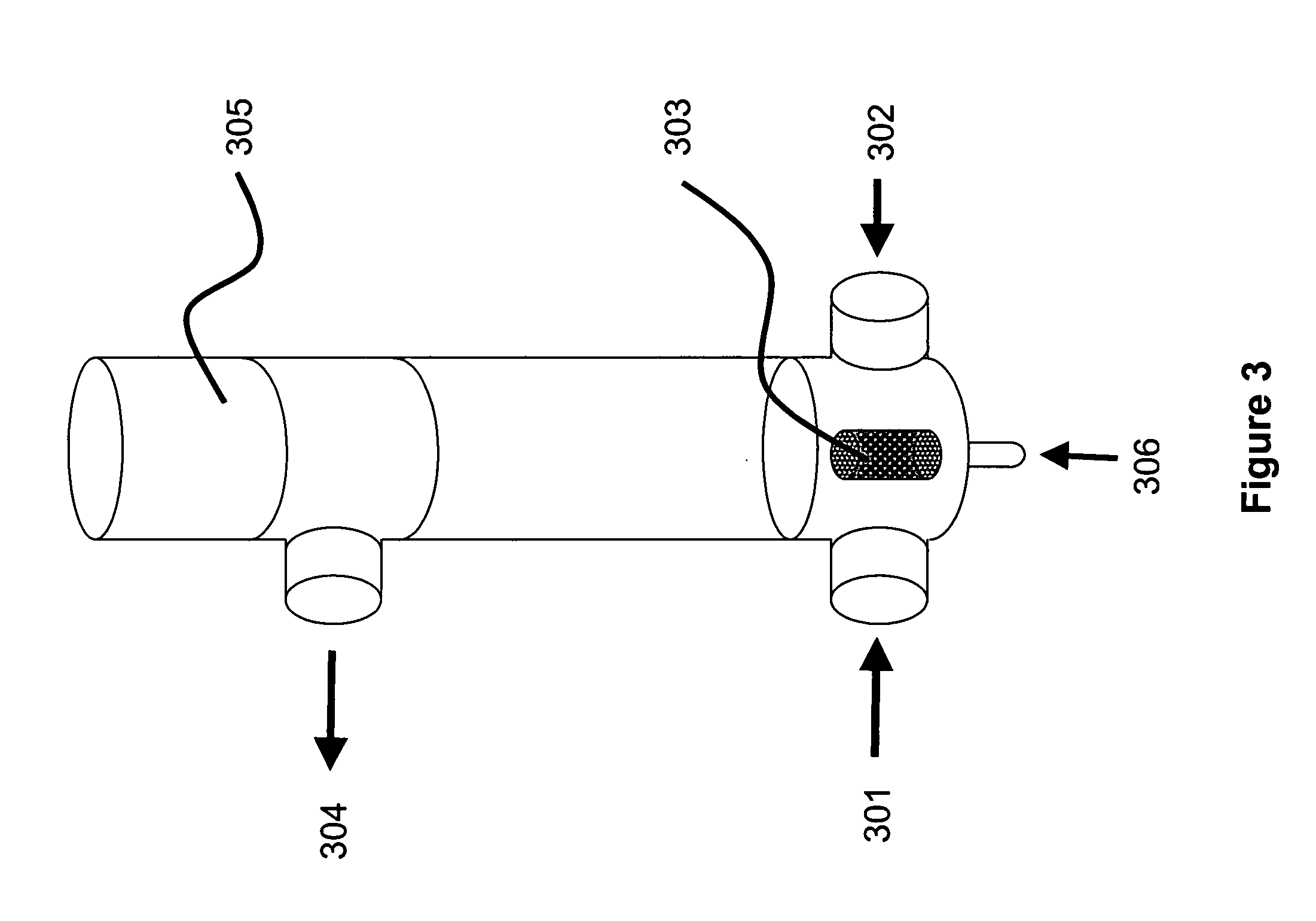Devices and methods for biomaterial production
a biomaterial and cell technology, applied in the field of apparatus and scalable methods of lysing cells, can solve the problems of increasing product costs, increasing product costs, and requiring higher production scales, and achieves rapid and cost effective, high shear, and efficient separation of insoluble components.
- Summary
- Abstract
- Description
- Claims
- Application Information
AI Technical Summary
Benefits of technology
Problems solved by technology
Method used
Image
Examples
example 1
E. coli cells containing plasmid pAV0124 were fermented to high density and recovered by centrifugation. Approximately 4.0 kg (wet weight) of cell paste was suspended in a resuspension buffer comprising 25 mM Tris, 10 mM Na2EDTA, pH 8, to a final volume of approximately 28 L. The resulting cell suspension had an OD600 of 65.8. This cell suspension was pumped at 300 mL / min into one side of a “Y” connector. Simultaneously, lysis solution comprising 0.2 N NaOH and 1% SDS was pumped at 300 mL / min into the other side of the “Y” connector. The combined fluids exiting the “Y” connector were immediately passed through a Silverson Model L4R rotor / stator mixer fitted with a standard Emulsor Screen and an In-line assembly. The mixer was operated at a rotor speed of 765 rpm.
The fluid exiting the rotor / stator mixer was passed through a 50-foot, 0.625 inch ID holding coil. At a total flow rate of approximately 600 mL / min, transit time through the holding coil was approximately 5 minutes, which ...
example 2
The filtered, diluted lysate from Example 1 was further purified by anion exchange. A 260 mL bed volume Pall Mustang™ Q cartridge was equilibrated with 4 L of Q equilibration / wash solution, comprising 10 mM Tris, 1 mM Na2EDTA, 0.67 M NaCl, pH 8. 220 L of material prepared in Example 1 was pumped onto the Q cartridge at a flow rate of approximately 2-3 L / min. After loading, the cartridge was washed with equilibration buffer at approximately 1 L / min until the A260 of the effluent approached baseline. Plasmid was eluted from the cartridge with Q elution buffer, comprising 10 mM Tris, 1 mM Na2EDTA, 1 M NaCl, pH 8, pumped at 800 mL / min. Absorbance of the cartridge effluent at 260 nm was monitored and recorded using a strip-chart recorder. Elution was terminated when the A260 returned to baseline. Total eluate volume was approximately 7.0 L and contained a total of approximately 3900 mg of DNA based on A260 (assuming a 1 mg / mL solution of DNA has an A260 of 1.0 in a 1 cm path length cell...
example 3
E. coli cells containing plasmid pAV0124 were fermented to high density and recovered by centrifugation. Approximately 3.8 kg (wet weight) of cell paste was suspended in 31.6 L of resuspension buffer, to an OD600 of 79.4. Lysis, neutralization / precipitation, and collection in the settling tank were performed as in Example 1. Flow rates were 300 mL / min for cell suspension and lysis solution, and 600 mL / min for neutralization / precipitation solution. The Silverson L4R, fitted as before, was operated at a rotor speed of 747 rpm. Transit time through the holding coil between lysis and neutralization / precipitation was approximately 5 minutes. Compressed air was sparged through the bubble mixer at 2 slpm. Total fluid volumes included 26.6 L of cell suspension, 5 L of resuspension tank wash with resuspension buffer, 31.6 L of lysis solution, and 53.2 L of neutralization / precipitation solution, for a nominal total of 116.4 L.
Once all of the material was collected in the settling tank, a va...
PUM
| Property | Measurement | Unit |
|---|---|---|
| residence-time | aaaaa | aaaaa |
| linear flow rates | aaaaa | aaaaa |
| particle size | aaaaa | aaaaa |
Abstract
Description
Claims
Application Information
 Login to View More
Login to View More - R&D
- Intellectual Property
- Life Sciences
- Materials
- Tech Scout
- Unparalleled Data Quality
- Higher Quality Content
- 60% Fewer Hallucinations
Browse by: Latest US Patents, China's latest patents, Technical Efficacy Thesaurus, Application Domain, Technology Topic, Popular Technical Reports.
© 2025 PatSnap. All rights reserved.Legal|Privacy policy|Modern Slavery Act Transparency Statement|Sitemap|About US| Contact US: help@patsnap.com



